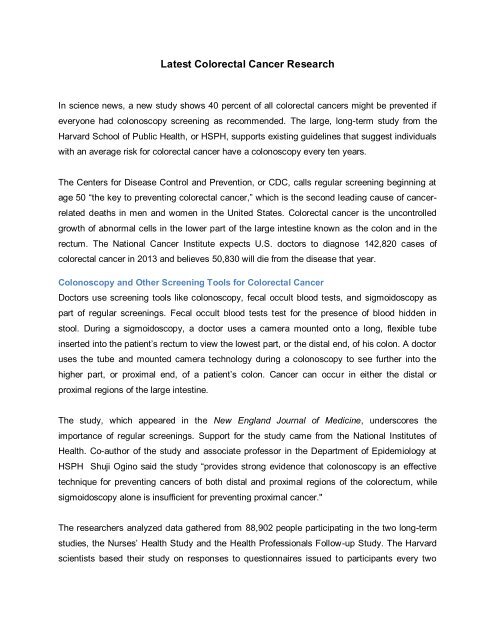Latest Colorectal Cancer Research
A recent study has shown that a great majority of colorectal cancers may be preventable.
A recent study has shown that a great majority of colorectal cancers may be preventable.
Create successful ePaper yourself
Turn your PDF publications into a flip-book with our unique Google optimized e-Paper software.
<strong>Latest</strong> <strong>Colorectal</strong> <strong>Cancer</strong> <strong>Research</strong><br />
In science news, a new study shows 40 percent of all colorectal cancers might be prevented if<br />
everyone had colonoscopy screening as recommended. The large, long-term study from the<br />
Harvard School of Public Health, or HSPH, supports existing guidelines that suggest individuals<br />
with an average risk for colorectal cancer have a colonoscopy every ten years.<br />
The Centers for Disease Control and Prevention, or CDC, calls regular screening beginning at<br />
age 50 “the key to preventing colorectal cancer,” which is the second leading cause of cancerrelated<br />
deaths in men and women in the United States. <strong>Colorectal</strong> cancer is the uncontrolled<br />
growth of abnormal cells in the lower part of the large intestine known as the colon and in the<br />
rectum. The National <strong>Cancer</strong> Institute expects U.S. doctors to diagnose 142,820 cases of<br />
colorectal cancer in 2013 and believes 50,830 will die from the disease that year.<br />
Colonoscopy and Other Screening Tools for <strong>Colorectal</strong> <strong>Cancer</strong><br />
Doctors use screening tools like colonoscopy, fecal occult blood tests, and sigmoidoscopy as<br />
part of regular screenings. Fecal occult blood tests test for the presence of blood hidden in<br />
stool. During a sigmoidoscopy, a doctor uses a camera mounted onto a long, flexible tube<br />
inserted into the patient’s rectum to view the lowest part, or the distal end, of his colon. A doctor<br />
uses the tube and mounted camera technology during a colonoscopy to see further into the<br />
higher part, or proximal end, of a patient’s colon. <strong>Cancer</strong> can occur in either the distal or<br />
proximal regions of the large intestine.<br />
The study, which appeared in the New England Journal of Medicine, underscores the<br />
importance of regular screenings. Support for the study came from the National Institutes of<br />
Health. Co-author of the study and associate professor in the Department of Epidemiology at<br />
HSPH Shuji Ogino said the study “provides strong evidence that colonoscopy is an effective<br />
technique for preventing cancers of both distal and proximal regions of the colorectum, while<br />
sigmoidoscopy alone is insufficient for preventing proximal cancer."<br />
The researchers analyzed data gathered from 88,902 people participating in the two long-term<br />
studies, the Nurses’ Health Study and the Health Professionals Follow-up Study. The Harvard<br />
scientists based their study on responses to questionnaires issued to participants every two
years between 1998 and 2008. Among the participants, researchers identified 1,815 cases of<br />
colorectal cancer and 474 deaths from the disease.<br />
The Harvard scientists found that both sigmoidoscopy and colonoscopy lowered the risk for<br />
developing or dying from colorectal cancer in the distal, or lower part of the colon but that only<br />
colonoscopy reduced the risk for cancer in the proximal, or higher part of the large intestine.<br />
Sigmoidoscopy alone is unlikely to reduce the risk for developing or dying from cancer that<br />
starts in the upper portion of the colon.<br />
Additionally, the researchers found that widespread compliance with recommended<br />
colonoscopy screenings every ten years could reduce the overall prevalence of colorectal<br />
cancer by 40 percent. These findings could help improve and strengthen the current guidelines<br />
for colorectal cancer screening.<br />
For updated information on cancer research, science news articles, and current science events<br />
visit our website at www.LabRoots.com



